I've been maintaining a Windows CE app for some time now (over a year) and have produced new versions of it from time to time, copying them to the handheld device[s] and running the new versions there.
Today, though, I created a new Windows CE app for the first time. It is a very simple utility.
To create it in VS 2008, I selected a C# "Smart Device Project" template, added a few controls and a bit of code, and built it.
Here are some of the options I selected:

I copied the .exe produced via building the project to the handheld device's Program Files folder:

...but it won't run. Is it in the wrong location? Does it need some ancillary files copied over? Is there some other sort of setup I need to do to get it to run? Or what?
UPDATE
Since there's not much of it, I'm pasting ALL the code below in case somebody thinks my code could be the problem:
using System;
using System.Linq;
using System.Collections.Generic;
using System.ComponentModel;
using System.Data;
using System.Drawing;
using System.Text;
using System.Windows.Forms;
using System.IO.Ports;
namespace PrinterCommanderCE
{
public partial class PrinterCommanderForm : Form
{
public PrinterCommanderForm()
{
InitializeComponent();
}
private void btnSendCommands_Click(object sender, EventArgs e)
{
SendPrinterCommands();
}
private void SendPrinterCommands()
{
bool successfulSend = false;
const string quote = "\"";
string keepPrinterOn = string.Format("! U1 setvar {0}power.dtr_power_off{0} {0}off{0}", quote);
string shutPrinterOff = string.Format("! U1 setvar {0}power.dtr_power_off{0} {0}on{0}", quote);
string advanceToBlackBar = string.Format("! U1 setvar {0}media.sense_mode{0} {0}bar{0}", quote);
string advanceToGap = string.Format("! U1 setvar {0}media.sense_mode{0} {0}gap{0}", quote);
if (radbtnBar.Checked)
{
successfulSend = SendCommandToPrinter(advanceToBlackBar);
}
else if (radbtnGap.Checked)
{
successfulSend = SendCommandToPrinter(advanceToGap);
}
if (successfulSend)
{
MessageBox.Show("label type command successfully sent");
}
else
{
MessageBox.Show("label type command NOT successfully sent");
}
if (ckbxPreventShutoff.Checked)
{
successfulSend = SendCommandToPrinter(keepPrinterOn);
}
else
{
successfulSend = SendCommandToPrinter(shutPrinterOff);
}
if (successfulSend)
{
MessageBox.Show("print shutoff command successfully sent");
}
else
{
MessageBox.Show("print shutoff command NOT successfully sent");
}
}
private bool SendCommandToPrinter(string cmd)
{
bool success = false;
try
{
SerialPort serialPort = new SerialPort();
serialPort.BaudRate = 19200;
serialPort.Handshake = Handshake.XOnXOff;
serialPort.Open();
serialPort.Write(cmd);
serialPort.Close();
success = true;
}
catch
{
success = false;
}
return success;
}
}
}
UPDATE 2
Based on this, I added a global exception handler to the app so that Program.cs is now:
namespace PrinterCommanderCE
{
static class Program
{
[MTAThread]
static void Main()
{
AppDomain currentDomain = AppDomain.CurrentDomain;
currentDomain.UnhandledException += new UnhandledExceptionEventHandler(GlobalExceptionHandler);
Application.Run(new PrinterCommanderForm());
}
static void GlobalExceptionHandler(object sender, UnhandledExceptionEventArgs args)
{
Exception e = (Exception)args.ExceptionObject;
MessageBox.Show(string.Format("GlobalExceptionHandler caught : {0}", e.Message));
}
}
}
Yet running the new build shows nothing - it just "flashes" momentarily with about as much verbosity as Lee Harvey Oswald after Jack Ruby's friendly visit.
UPDATE 3
Could the problem be related to this, and if so, how to solve it?
The circumstance that both my updated version of an existing app AND this brand new and simple app refuse to run indicate there is something fundamentally flawed somewhere in the coding, building, or deployment process.
UPDATE 4
As this is a minimal utility, the reason it (and my legacy, much more involved) app are not working may have something to do with the project properties, how it's being built, a needed file not being copied over, or...???
NOTE: The desktop icon is "generic" (looks like a blank white form); this perhaps indicates a problem, but is it indicative of something awry or is it a minor (aesthetics-only) problem?
UPDATE 5
In Project > Properties..., Platform is set to "Active (Any CPU)" and Platform target the same ("Active (Any CPU)")
I have read that this is wrong, that it should be "x86", but there is no "x86" option available - Any CPU is the only one...?!?
UPDATE 6
In Project > Properties... > Devices, the "Deploy the latest version of the .NET Compact Framework (including Service Packs)" is checked. Is this as it should be?
UPDATE 7
Okay, here's the really strange part of all this:
I have two CF/CE apps that I need to run on these Motorola/Symbol 3090 and 3190 handheld devices.
One is this simple utility discussed above. I find that it actually does run on one of the devices (the 3190, FWIW). So it runs on one device, but not on the other.
HOWEVER, the other (legacy) .exe is the opposite - it runs on the 3090 (where the utility will not even start up), but not on the 3190.
So the utility's needs are met by the 3190, and the legacy util's needs are met by the 3090. However, the NEW version of the legacy app does not run on either device!
I am baffled; I feel as Casey Stengel must have when speaking once of his three catchers: "I got one that can throw but can't catch, one that can catch but can't throw, and one who can hit but can't do either."
UPDATE 8
The 3190 has a newer version of the CF installed; it seems that both the new and the old apps should run on the new device with the newer CE, but they don't - only the one built against/for the new framework does...
UPDATE 9
Here is what the 3090 looks like:

UPDATE 10
So I have two exes, one that runs on the devices (both of them now), and the other that will run on neither of the devices. The two exesw seem almost identical. I compared them with three tools: Red Gates' .NET Reflector; JetBrains' dotPeek, and Dependency Walker.
Here is what I found:
Dependency Walker Both seem to have the same errors about missing dependencies (I didn't have them in the same folder with their dependent assemblies is probably the problem there)
.NET Reflector The nonworking file has this entry that the working file does not:
[assembly: Debuggable(0x107)]
Is this the problem and, if so, how can I change it?
JetBrains dotPeek The References in the working copy of the exe are all version 1.0.50000.0
The non-working exe has an identical list of References, and the same version number.
There is this difference, though:
For the working .exe, dotPeek says, "1.4.0.15, msil, Pocket PC v3.5" For the non-working .exe, dotPeek says, "1.4.0.15, msil, .Net Framework v4.5"
Is this the problem and, if so, how can I change the non-working .exe to match the working one?
This last is disconcerting, primarily because I see no place in the non-working (newer) version of the project where a "4.5" string exists. Where could dotPeek be getting that information?
UPDATE 11
I do know now that the problem is somewhere between these two MessageBox.Show()s, because the first one I see, but not the second:
public static int Main(string [] args)
{
try
{
// A home-brewed exception handler (named ExceptionHandler()) is already defined, but I'm adding a global one
// for UNHANDLED exceptions (ExceptionHandler() is explicitly called throughout the code in catch blocks).
MessageBox.Show("made it into Main method"); // TODO: Remove after testing <= this one is seen
AppDomain currentDomain = AppDomain.CurrentDomain;
currentDomain.UnhandledException += new UnhandledExceptionEventHandler(GlobalExceptionHandler);
string name = Assembly.GetExecutingAssembly().GetName().Name;
IntPtr mutexHandle = CreateMutex(IntPtr.Zero, true, name);
long error = GetLastError();
if (error == ERROR_ALREADY_EXISTS)
{
ReleaseMutex(mutexHandle);
IntPtr hWnd = FindWindow("#NETCF_AGL_BASE_",null);
if ((int) hWnd > 0)
{
SetForegroundWindow(hWnd);
}
return 0;
}
ReleaseMutex(mutexHandle);
DeviceInfo devIn = DeviceInfo.GetInstance();
Wifi.DisableWifi();
// Instantiate a new instance of Form1.
frmCentral f1 = new frmCentral();
f1.Height = devIn.GetScreenHeight();
f1.Text = DPRU.GetFormTitle("DPRU HHS", "", "");
MessageBox.Show("made it before Application.Run() in Main method"); // TODO: Remove after testing <= this one is NOT seen
Application.Run(f1);
devIn.Close();
Application.Exit();
return 0;
}
catch(Exception ex)
{
DPRU.ExceptionHandler(ex, "Main");
return 0;
}
} // Main() method
UPDATE 12
More specifically, I've got infinite looping going on somehow; By mashing the "Ent" pill on the handheld device (that's what the button looks like - a "lozenge") - it sounds like gerbils tap-dancing (as debugging MessageBox.Show()s in two methods pop up and are dismissed over and over ad infinitum ad (literally) nauseum).